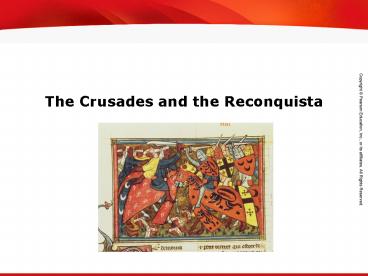The Crusades and the Reconquista - PowerPoint PPT Presentation
1 / 14
Title:
The Crusades and the Reconquista
Description:
The Crusades and the Reconquista Identify the advanced civilizations that were flourishing in 1050. Explain the causes and effects of the Crusades. – PowerPoint PPT presentation
Number of Views:1704
Avg rating:3.0/5.0
Title: The Crusades and the Reconquista
1
The Crusades and the Reconquista
2
Objectives
- Identify the advanced civilizations that were
flourishing in 1050. - Explain the causes and effects of the
Crusades. - Summarize how Christians in Spain carried out the
Reconquista.
3
Terms and People
- Crusades a series of wars in which Christians
battled Muslims for control of lands in the
Middle East - Holy Land Jerusalem and other places in
Palestine where Jesus had lived and preached - Pope Urban II the pope who urged Christian
bishops and nobles to take the Holy Land from
Muslim control - Reconquista the campaign to drive Muslims from
the Iberian peninsula
4
Terms and People (continued)
- Ferdinand and Isabella Spanish monarchs who
completed the Reconquista - Inquisition a Church court set up to try people
accused of heresy
5
How did the Crusades change life in Europe and
beyond?
Thousands of Europeans took part in the Crusades.
In these wars, Christians battled Muslims for
control of lands in the Middle East. The
encounters of Europeans in the Middle East
increased the pace of change at home.
6
- Muslims had built an advanced society in the
Middle East. - Muslim conquerors and traders had spread from
Spain to India. - India, China, West Africa, and Central America
had advanced societies as well.
By 1050, Western Europe was emerging from a
period of isolation. Civilizations elsewhere
were thriving.
7
Rumors spread that Turks were harassing Christian
pilgrims. Hoping to gain power and heal the
schism in the Church, Pope Urban II urged bishops
and nobles to fight the Turks. God wills it!
roared the assembly, and the Crusades began.
In the 1050s, Muslim Turks invaded the Byzantine
empire. They extended their power to the Holy
Land in Palestine.
8
Crusaders set off for the Holy Land.
Some were driven by religious zeal, others by a
thirst for adventure. Some hoped to win land and
wealth.
9
Christian knights captured Jerusalem in 1099, but
in 1187, it fell again to the Muslims.
10
The Crusades did not achieve their goal of
retaking the Holy Land.
By 1291, Muslim armies captured the last
Christian outpost in the Holy Land.
During the Fourth Crusade, they fought other
Christians.
During the Third Crusade, Europeans failed to
retake Jerusalem.
11
Effects of the Crusades
They left a bitter legacy of religious hatred.
European economies expanded as trade increased
and the use of money became more common.
As monarchs raised armies, their power increased.
Europeans developed a wider worldview, and some
set off on a new age of exploration.
12
The crusading spirit continued in Spain, in a
campaign called the Reconquista.
- The goal was to drive Muslims off the Iberian
peninsula. - By 1300, Christians controlled the entire region
except Granada. - Muslim influence continued, however, and shaped
the arts and literature in Christian Spain.
13
When Ferdinand and Isabella married in 1469, a
unified Spain was formed.
- They made the final push against Muslims in
Granada. - Granada fell in 1492. The tradition of relative
religious tolerance experienced under the Muslims
was at an end.
14
Isabella wanted to bring religious unity to Spain.
She ended tolerance of non-Christians. More than
150,000 Jews and Muslims fled Spain.
She instituted the Inquisition, which tried
people accused of heresy. Many who refused to
conform were burned at the stake.































